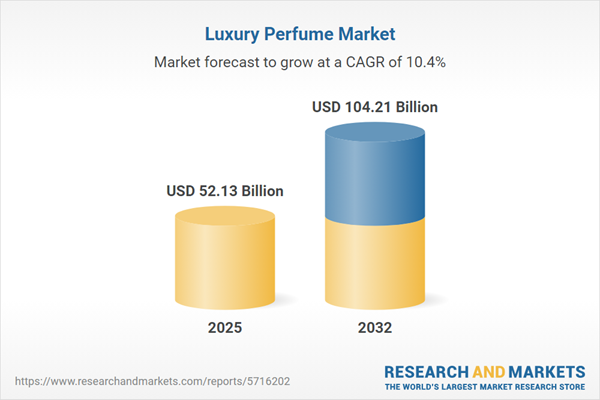Speak directly to the analyst to clarify any post sales queries you may have.
The luxury perfume market is rapidly transforming, requiring senior decision-makers to adapt strategies for technological innovation, sustainability imperatives, and evolving global consumer preferences. Sector leaders must prioritize agile planning and evidence-based insights to sustain relevance in a highly competitive landscape.
Market Snapshot: Luxury Perfume Market Growth and Dynamics
The luxury perfume market is experiencing marked expansion, rising from USD 47.15 billion in 2024 to USD 52.13 billion in 2025, with an expected trajectory toward USD 104.21 billion by 2032. This growth, at a CAGR of 10.42%, is supported by increasing consumer demand for diverse fragrance offerings, heightened digital engagement, and a stronger focus on environmentally responsible manufacturing, especially within the premium segment. As industry participants adapt to regulatory changes, generational shifts in consumption, and the emergence of hybrid retail models, competitive advantage now relies on operational scalability, resilience, and brand credibility.
Scope & Segmentation: Comprehensive Luxury Perfume Market Coverage
This report provides actionable intelligence tailored for B2B leaders, offering sector-wide segmentation to assist informed decision-making across marketing, procurement, and geographic growth strategies. Each key market dimension is summarized below for clarity:
- Product Types: Eau De Cologne, Eau De Parfum, Eau De Toilette, and Eau Fraîche allow brands to refine portfolios for desired scent intensity and consumer occasions.
- Fragrance Families: Floral (e.g., Jasmine, Lily, Rose, Orange Blossom), Fresh (Bergamot, Lemon, Mint), Oriental (Amber, Musk, Spices, Vanilla), and Woody (Cedarwood, Patchouli, Sandalwood) enable providers to cater to evolving scent preferences worldwide.
- Ingredients Origin: Coverage includes Natural and Synthetic sourcing, underscoring the importance of transparent, sustainable supply networks aligned with regulatory demands.
- Target Audience: Market segments comprise Men, Women, and Unisex products, helping brands shape messaging and experiences to suit varied buyer groups.
- Distribution Channels: Channels span Offline (brand stores, duty-free, large retailers) and Online (brand websites, eCommerce), supporting optimized multi-channel access.
- Regional Markets: Report features in-depth analysis across Americas (notably United States and Brazil), Europe, Middle East & Africa (United Kingdom, France, UAE, South Africa), and Asia-Pacific (China, India, Japan, Australia), allowing for customized go-to-market initiatives in distinct regions.
- Company Coverage: Strategic benchmarking of major industry participants, including Burberry Group PLC, Chanel Limited, Creed Fragrances by Kering S.A., Dolce & Gabbana S.R.L., Giorgio Armani S.p.A., Hermès International S.A., LVMH Moët Hennessy Louis Vuitton, PUIG S.L., Shiseido Company Limited, and The Estée Lauder Companies Inc.
Key Takeaways: Strategic Insights for Senior Decision-Makers
- Personalization and brand narrative influence customer loyalty, with innovation in scent creation and digital engagement crucial at each consumer interaction.
- Sustainability shapes emerging business models, prompting brands to invest in ethical sourcing, robust supply chain transparency, and enhanced brand credibility.
- Technology is increasingly integrated; artificial intelligence facilitates tailored product recommendations and immersive digital retail tools strengthen cross-channel engagement.
- Locally driven consumer tastes require ongoing adaptation—some regions favor experimental scents, while others value tradition or renewed classics, guiding refined market approaches.
- Expansion into adjacent product categories, such as home fragrances and luxury lifestyle goods, supports cross-selling as part of larger customer experience strategies.
- Partnerships with biotechnology providers and traceability experts promote supply chain integrity and facilitate compliance, reinforcing brand trust and regulatory standards.
Tariff Impact: Adapting Procurement and Competitive Strategies in 2025
Recent adjustments to U.S. tariffs on imported fragrances have prompted brands to recalibrate procurement processes, managing cost fluctuations through risk-sharing with channel partners, increased nearshoring and local sourcing, and greater vertical integration. These steps are vital for operational flexibility and resilience in the premium fragrance value chain.
Methodology & Data Sources
This analysis synthesizes insights from executive interviews, trade data reviews, digital sentiment analysis, regional macroeconomic evaluation, and company disclosure assessment, adhering strictly to data privacy regulations.
Why This Report Matters: Evidence-Based Decision Support
- Enables leaders to anticipate and respond to evolving regulation, shifting consumer behaviors, and core market drivers in luxury fragrances.
- Facilitates refined B2B growth strategies by benchmarking innovation, channel advances, and region-specific market developments.
- Supports decision-making with supply chain transparency, distribution optimization, and adaptable market positioning.
Conclusion
The luxury perfume sector’s complex environment demands informed, agile leadership. By anticipating market shifts and executing timely, data-backed strategies, organizations can achieve continued relevance and sustainable progress on a global scale.
Additional Product Information:
- Purchase of this report includes 1 year online access with quarterly updates.
- This report can be updated on request. Please contact our Customer Experience team using the Ask a Question widget on our website.
Table of Contents
3. Executive Summary
4. Market Overview
7. Cumulative Impact of Artificial Intelligence 2025
List of Figures
Companies Mentioned
The key companies profiled in this Luxury Perfume market report include:- Burberry Group PLC
- Calvin Klein Inc. by PVH Corp.
- Chanel Limited
- Clive Christian Perfume Limited
- Compagnie Financière Richemont SA
- Creed Fragrances by Kering S.A.
- Diptyque SAS
- Dolce & Gabbana S.R.L.
- FLORIS LONDON
- Gianni Versace S.r.l. by Capri Holdings Limited
- Giorgio Armani S.p.A.
- Hermès International S.A
- ITC Limited
- Krigler
- L&L Luxury Company Ltd.
- L'Oréal S.A.
- LVMH Moët Hennessy Louis Vuitton
- Maison Des Parfums
- Prada S.p.A.
- PUIG, S.L.
- Roja Parfums Holdings Limited
- Shiseido Company Limited
- The Estée Lauder Companies Inc.
Table Information
| Report Attribute | Details |
|---|---|
| No. of Pages | 196 |
| Published | October 2025 |
| Forecast Period | 2025 - 2032 |
| Estimated Market Value ( USD | $ 52.13 Billion |
| Forecasted Market Value ( USD | $ 104.21 Billion |
| Compound Annual Growth Rate | 10.4% |
| Regions Covered | Global |
| No. of Companies Mentioned | 24 |









